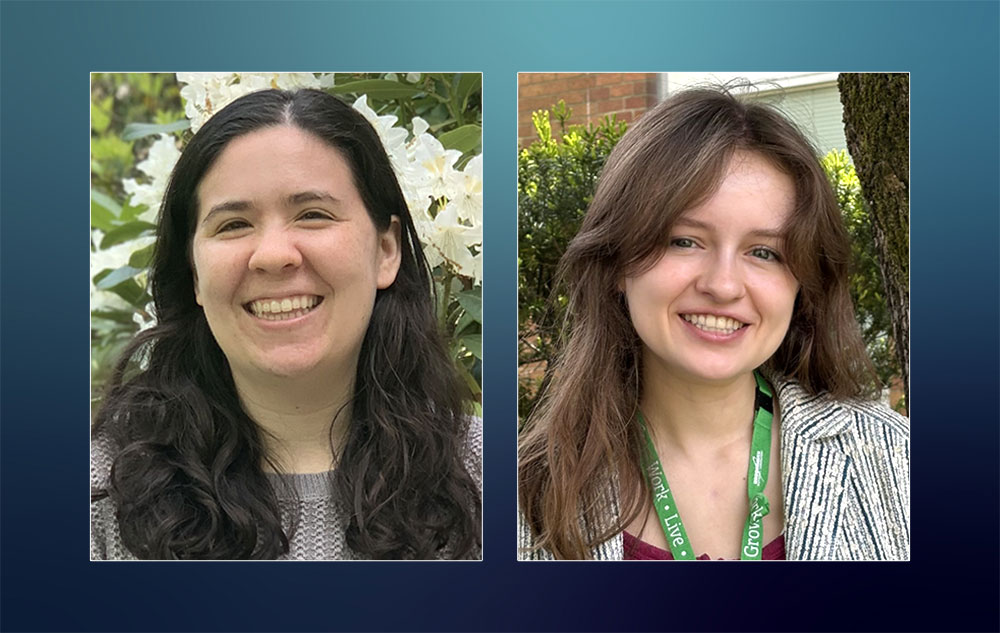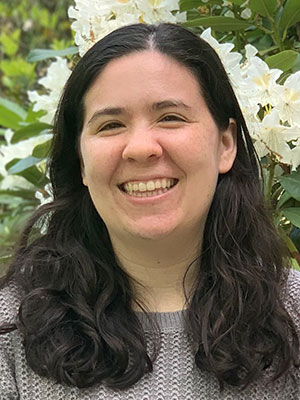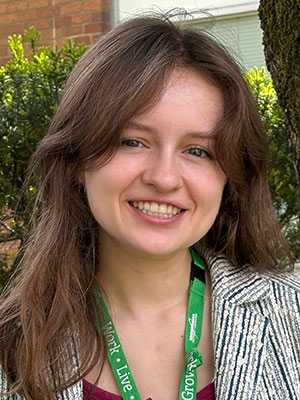BWIS Announces 2024 Chasman Award Winners; Ceremony and Talks 6/17
Awardees noted for their work on single-atom catalysts, ATLAS detector upgrades
June 10, 2024

Kali Rigby (left) and Emily Duden
Brookhaven Women in Science (BWIS) has named Kali Rigby of Yale University and Emily Duden of Brandeis University as the recipients of the 2024 Renate W. Chasman Award. Rigby and Duden will each give a talk and receive their award at the U.S. Department of Energy’s (DOE) Brookhaven National Laboratory on Monday, June 17, at 12 p.m. in Room B in building 488 and on Zoom.
Add this event to your calendar
The talk is sponsored by BWIS and is open to all employees and the public. Government-issued identification that includes a photograph, such as a passport or driver’s license, is required for site access for those 16 years of age and older.
Rigby will give a talk, titled “Stability of single-atom catalysts for water treatment: Investigating dynamic aggregation using in situ X-ray absorption spectroscopy,” and Duden will give a talk, titled “Building the future of particle physics with the new ATLAS Inner Tracker.”
The Chasman Award encourages women to pursue careers in science, technology, engineering, or mathematics (STEM) fields and honors the memory and scientific contributions of the late Renate Chasman, a noted physicist at Brookhaven National Laboratory. Her work influenced the design of particle accelerators around the world, including Brookhaven’s National Synchrotron Light Source (NSLS) and its successor, NSLS-II, a DOE Office of Science user facility.
Rigby and Duden will each receive $3,400. This year’s awards are funded by Brookhaven Science Associates (BSA), the company that operates Brookhaven Lab on behalf of DOE, as well as generous contributions from the Long Island Section of the American Nuclear Society (LIANS), NSLS-II, Brookhaven Lab’s Human Resources Directorate, the Lab’s Energy and Photon Sciences Directorate, the Lab’s Nuclear and Particle Physics Directorate, the Center for Functional Nanomaterials Users Executive Committee, the NSLS-II Users Executive Committee, and Brookhaven’s Computational Science Initiative.
About the 2024 recipients
Kali Rigby
“I am extremely grateful to receive the Chasman Award,” said Rigby, who is a fifth-year Ph.D. candidate at Yale University. “I would like to thank my advisor, Jaehong Kim, for his guidance and support, as well as Eli Stavitski and Denis Leshchev at Brookhaven Lab, who have been immensely helpful with experiments and analysis.”
Rigby grew up in New Jersey and went to Brown University, where she received her bachelor's in chemistry in 2019. She started graduate school at Yale University in the Chemical and Environmental Engineering Department, where she works with Kim studying how single-atom catalysts (SACs) behave during catalytic reactions related to water treatment.
SACs are a rapidly expanding research field in catalyst science due to their atomic efficiency and catalytic performance. SACs have unique advantages due to their isolated makeup, such as minimizing waste by using metal atoms more efficiently.
Given an ever-increasing global demand for energy, SACs benefit a number of applications, such as electrocatalysis, photocatalysis, and energy conversion. Over the years, various types of catalysts have been used for water treatment to eliminate toxic organic substances from drinking water.
Because of their structure, single atoms are often unstable and will aggregate, or collect, into larger particles. Rigby aims to understand this process and how the catalyst reaction influences this aggregation.
Rigby’s work uses X-ray absorption spectroscopy at the Inner Shell Spectroscopy (ISS) beamline at NSLS-II, which enables scientists to monitor single-atom stability and aggregation during reaction conditions.
“As we design and test materials for environmental applications, we have to know what is going on with the catalyst during operation. Catalyst stability is often an overlooked piece of the discussion regarding SACs,” said Rigby. “Learning how SACs change in response to reaction conditions is key if we hope to translate SACs to real environmental remediation scenarios.”
SACs are being tested for their ability to treat a variety of water contaminants and air pollutants, so by investigating their behavior in aqueous and gaseous environments, and in the presence of pollutants, scientists like Rigby hope to understand structural changes and if these changes are good or bad for the reactions.
Rigby notes the personal importance of applying her academic knowledge to improving real-world challenges.
“This work during my Ph.D. has allowed me to apply chemistry principles to the bigger picture of water treatment,” said Rigby. “I've really enjoyed this intersection, where I can synthesize materials, use advanced characterization techniques, and test their effectiveness for pollutant remediation. I've bridged two important interests of mine into my work, and I hope to continue the intersection of chemistry and environment in my future.”
Emily Duden
Emily Duden grew up on a dairy farm in Minnesota and attended Winona State University, where she received a bachelor's degree in physics and mathematics. In 2021, she began a Ph.D. at Brandeis University.
“I am extremely grateful to receive this award. I admire Renate Chasman immensely and feel privileged to be a part of honoring her memory. Thank you to Brookhaven Women in Science and the selection committee,” said Duden.
“I'd also like to thank the many outstanding mentors who supported me during this work, including my advisor Gabriella Sciolla and Brookhaven Lab scientists Alessandro Tricoli, Dave Lynn, and Stefania Stucci. Finally, thank you to the Omega Group at the Lab, which has been incredibly welcoming and supportive during my time here.”
Currently, Duden works on the ATLAS experiment at the Large Hadron Collider (LHC) based at CERN, the European Organization for Nuclear Research, in Geneva, Switzerland. The LHC is the largest and most powerful accelerator ever constructed. It hosts the ATLAS detector, one of the detectors that famously discovered evidence of the Higgs boson in 2012. This discovery completed the Standard Model, physics’ most tested—but not fully complete—explanation of the subatomic world.
Powerful magnets inside the LHC direct two beams of high-energy particles, traveling close to the speed of light, in opposite directions around the nearly 17-mile ring, until they collide at four designated points. The particles’ impacts, which may reveal new particles and phenomena, are captured by four different detectors, one of which is ATLAS.
The LHC will undergo an upgrade known as the High-Luminosity LHC (HL-LHC), which will increase the number of collisions between particles, providing more data for experiments. HL-LHC is expected to start operating around 2029.
Duden researches the new ATLAS inner tracker (ITk) that will replace the LHC’s inner detector, which measures the direction, momentum, and charge of electrically charged particles produced in each proton-proton collision. The ITk will enable researchers to observe low-probability, or rarely occurring, phenomena that may reveal “new physics.”
For about a year, Duden has been working at Brookhaven Lab to conduct research on ITk. Later this summer, she will move to CERN for the remainder of her Ph.D. There, she will search for physics that remain unexplained by the Standard Model in Higgs boson decays to long-lived particles. All everyday matter is made up of long-lived particles.
“This is an exciting time in particle physics when no one knows where new data will take us. The forthcoming high luminosity phase of the LHC opens a realm of possible discoveries, and future detectors will push the frontier of knowledge even further,” said Duden. “I'm excited to see what mysteries of the universe we can unravel in my lifetime. In the meantime, I feel incredibly lucky to do what I do. I'm building a particle detector! What's cooler than that?”
Acknowledgments
This year’s award was administered by BWIS officers David Schlyer, a senior scientist emeritus, and Ed Sierra of the Quality Management Office.
“David and I, on behalf of BWIS, extend our deep appreciation to the Chasman review committee members for their expert advice and thorough evaluation of the candidates,” said Sierra.
The committee members are Milinda Abeykoon, physicist at NSLS-II; Diane Cabelli, researcher in the Chemistry Division; Maria Chamizo-Llatas, deputy associate laboratory director in the Nuclear and Particle Physics Directorate; Raymond Fliller, associate chair for environment, safety, health, and quality in the Collider-Accelerator Department; Masafumi Fukuto, program manager of the Complex Scattering Program at NSLS-II; and Peter Steinberg, distinguished scientist in the Physics Department.
“I am privileged to play a continuing part in the facilitation of the Chasman Award,” Sierra said. “I would like to thank David Schyler for his dedicated participation and Chris Weaver, of the Information Technology Division, for his assistance in managing the applicant database. I look forward to following the careers of Kali and Emily and their future exciting contributions to science.”
“It has been my great pleasure to participate in the Chasman Awards for the last eight years and to collect the information on all the past winners since the award was started in 1985,” Schlyer said. “The exceptional qualities of all the applicants make choosing just one or two each year a very difficult task, and Ed Sierra and I thank the committee members for accomplishing this task.”
To read more about Renate Chasman and previous years’ winners, visit the Chasman Award website.
To apply for the Chasman award, please visit the BWIS Awards and Prizes website.
BWIS, a nonprofit organization that supports and encourages the advancement of women in science and is open to all individuals, is funded by BSA. To learn more about BWIS, visit the BWIS website.
Brookhaven National Laboratory is supported by the Office of Science of the U.S. Department of Energy. The Office of Science is the single largest supporter of basic research in the physical sciences in the United States and is working to address some of the most pressing challenges of our time. For more information, visit science.energy.gov.
Follow @BrookhavenLab on social media. Find us on Instagram, LinkedIn, X, and Facebook.
2024-21899 | INT/EXT | Newsroom











